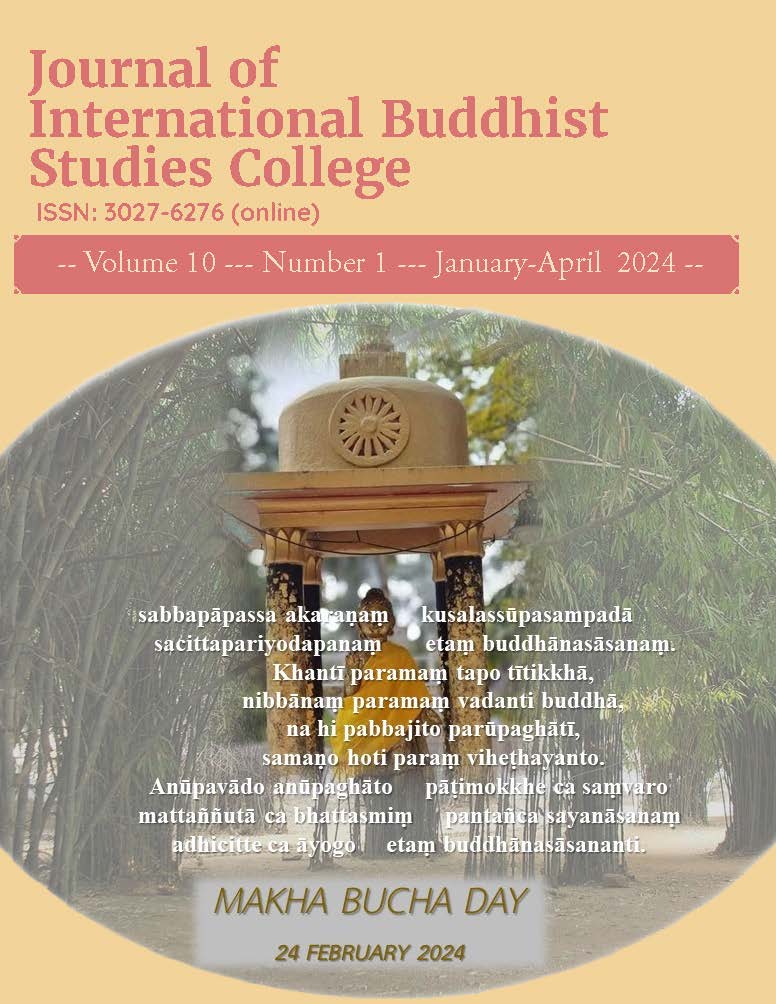A Buddhist-Muslim Partnership Model for Strengthening Solidarity in the Local Community: A Case-Study of Tha-It Subdistrict, Pakkred, Nonthaburi, Thailand
Main Article Content
Abstract
This article aims to study the development and implementation of a Buddhist-Muslim partnership model to strengthen community solidarity in Tha-It Subdistrict, Pakkred District, Nonthaburi Province, Thailand. It examines: (1) community solidarity and the factors that strengthen it between Buddhists and Muslims in Tha-It; (2) it designs, implements, evaluates, and follows up on a Buddhist-Muslim partnership program for enhancing community solidarity, and (3) presents a conceptual model for such partnerships.
Utilizing qualitative research methods, including documentary research, interviews, ethnography, participant observation, and content analysis, the study reveals several key findings:
- The literature suggests that religions can be a forceful tool in the construction of exclusivist identities in violent conflict. Addressing rising Islamophobia in Southeast Asia and Thailand and recognizing key Buddhist and Islamic principles that promote interreligious inclusivity is essential for fostering positive interfaith relations. Identities shaped by familial, ethnic, national, and religious ties can both foster unity and create obstacles. Understanding and managing these dynamics is crucial in multicultural societies, especially in Southeast Asia and Thailand. Nonetheless, the study challenges the Southeast Asian literature narrative that views religions primarily as threats, revealing that religious values and principles can also serve as a source of community strength and cohesion.
- Despite historical harmony, interfaith interaction initiatives in Tha-It remain limited, particularly in educating youth about mutual respect and understanding. Younger generations often lack interest in religious practices and lack knowledge about their own and others' religious traditions, leading to a gap in interfaith engagement. Introducing youth commissions in planning and executing interfaith activities represents a pioneering approach of this research. This strategy involves direct engagement of Tha-It's religious leaders, government officials, and youth, fostering an inclusive dialogue that values young individuals' contributions to interfaith relationships.
- The developed Buddhist-Muslim partnership model is structured around four stages: (1) establishing a partnership foundation, (2) engaging in interaction, (3) reflecting and learning, and (4) focusing on sustainability and continuous improvement. The first stage emphasizes mutual understanding and respect, especially among youth, incorporating teachings from Buddhism and Islam, aspects of the Royal Educational Policies of King Rama X, and conflict resolution education. The second stage promotes active engagement in community needs, inclusivity, and participation in projects. The reflection stage allows participants to share experiences and deepen interfaith understanding. Lastly, the model stresses continuous evaluation and collaboration with external bodies to ensure sustainability and responsiveness to community needs.
Article Details
The Journal of TCI is licensed under a Creative Commons Attribution-NonCommercial-NoDerivatives 4.0 International (CC BY-NC-ND 4.0) licence unless otherwise stated. Please read our Policies page for more information on Open Access, copyright and permissions.
References
Bhikkhu Bodhi. (2000). The Connected Discourses of the Buddha: A New Translation of the Samyutta Nikaya. Wisdom Publications.
Bhikkhu Bodhi. (2007). The discourse on the all-embracing net of views: The Brahmajala Sutta and Its Commentaries. Buddhist Publication Society.
Bhikkhu Bodhi. (2012). The Numerical Discourses of the Buddha: A Translation of the Anguttara Nikaya. Wisdom Publications.
Evans, J., Jo Starr, K., Corichi, M., & Miner, W. (2023). Buddhism, Islam and Religious Pluralism in South and Southeast Asia, Pew Research Center. https://policycommons.net/ artifacts/4825678/buddhism-islam-and-religious-pluralism-in-south-and-southeast-asia/5662407/
Frydenlund, I., & Jerryson, M. K. (eds.). (2020). Buddhist-Muslim Relations in a Theravada World. (pp. 1-21). Palgrave Macmillan.
Jerard, J., & Suresh, V. (2022). The Southeast Asian social cohesion radar: enhancing data-driven research. RSIS Commentaries, 110-22.
Jerryson, M. K. (2011). Buddhist Fury: Religion and Violence in Southern Thailand. Oxford University Press.
Khaosod English. (2015, July 26). Buddhist groups condemn murder of monk in deep south. https://www.khaosodenglish.com/politics/2015/07/26/1437889530/
News. (2022, August 17). Thailand’s South Rocked by Wave of Bomb and Arson Attacks. Aljazeera, https://www.aljazeera.com/news/2022/8/17/thailands-south-rocked-by-wave-of-bomb-and-arson-attacks.html.
Pathan, D., Tuansiri, E., & Koma, A. (2018). Understanding Anti-Islam Sentiment in Thailand. Samilan Press.
Putnam, R. D. (2000). Bowling alone: The collapse and revival of American community. Simon & Schuster.
Shafiq, M., & Abu-Nimer, M. (2011). Interfaith Dialogue: A Guide for Muslims. The International Institute of Islamic Thought.
Stiftung, B. (Ed.). (2018). What holds Asian societies together? Insights from the social cohesion radar. Verlag Bertelsmann Stiftung.


